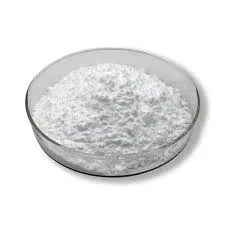
Dec . 04, 2024 10:53 Back to list
redispersible polymer powder manufacturing process
The Manufacturing Process of Redispersible Polymer Powder
Redispersible polymer powder (RDP) is a crucial component in various industries, particularly in construction, coatings, and adhesives. These powders are made from polymer emulsions that have been spray-dried to create a free-flowing powder that can be redispersed in water. The manufacturing process of RDP involves several steps that ensure the final product meets industry standards for performance and quality. This article will explore the various stages of producing redispersible polymer powder, from the initial polymer synthesis to the final drying process.
1. Polymer Synthesis
The first step in the manufacturing process of RDP is the synthesis of the polymer emulsion. This typically involves the polymerization of monomers in the presence of water, surfactants, and other additives. Commonly used monomers include vinyl acetate, ethylene, and styrene, among others. The polymerization occurs in a controlled environment where temperature, pressure, and pH levels are monitored to ensure the desired molecular weight and polymer properties are achieved.
During this stage, an emulsion is formed that consists of tiny polymer particles dispersed in water. The size and distribution of these particles are critical as they influence the properties of the final powder. Various techniques, including miniemulsion and microemulsion polymerization, can be employed to control the particle size and ensure uniformity.
2. Stabilization
Once the polymer emulsion is produced, it must be stabilized to prevent coalescence and phase separation. This is typically achieved through the addition of stabilizers or protective colloids, which help maintain the stability of the dispersion. The choice of stabilizer is essential as it can significantly affect the performance characteristics of the RDP, including its shelf-life, redispersibility, and final film properties.
3. Spray Drying
redispersible polymer powder manufacturing process

The core of the manufacturing process lies in the spray drying of the stabilized polymer emulsion. In this step, the emulsion is atomized into small droplets that are then subjected to hot air in a spray dryer. The rapid evaporation of water causes the polymer particles to agglomerate into a fine powder. Careful control of the drying parameters, such as inlet and outlet temperatures, air flow rates, and feed concentration, is crucial to ensure that the powder retains its redispersibility while achieving the desired moisture content and particle size.
High-quality RDP often requires a well-optimized spray drying process. Adjustments made during this stage can enhance the fluidity and solubility of the final product. In some cases, post-drying treatments may also be implemented to improve the performance characteristics of the powder, including the incorporation of additional additives for enhanced adhesion or flexibility.
4. Quality Control
Quality control is a vital aspect of RDP manufacturing. Throughout the production process, samples are taken for various tests, including particle size analysis, moisture content measurement, and redispersibility tests. These quality checks ensure that the final product conforms to specifications and performs well in its intended applications. Advanced analytical techniques, such as laser diffraction and dynamic light scattering, are often employed to assess the physical properties of the polymer powder.
5. Packaging and Storage
Once the redispersible polymer powder passes all quality checks, it is packaged in moisture-resistant bags to prevent rehydration and clumping during storage. Proper packaging is essential to maintain the integrity of the product and prolong its shelf-life. The powders are typically stored in a cool, dry place to prevent deterioration.
Conclusion
The manufacturing process of redispersible polymer powder is a complex and multi-step operation that requires careful control and optimization at each stage. From the synthesis of the polymer emulsion to the final drying process, each phase contributes to the characteristics and performance of the RDP. As industries continue to evolve and place higher demands on performance and sustainability, advancements in RDP manufacturing techniques will play a vital role in meeting these challenges while ensuring the quality and reliability of the final product.
-
Versatile Hpmc Uses in Different Industries
NewsJun.19,2025
-
Redispersible Powder's Role in Enhancing Durability of Construction Products
NewsJun.19,2025
-
Hydroxyethyl Cellulose Applications Driving Green Industrial Processes
NewsJun.19,2025
-
Exploring Different Redispersible Polymer Powder
NewsJun.19,2025
-
Choosing the Right Mortar Bonding Agent
NewsJun.19,2025
-
Applications and Significance of China Hpmc in Modern Industries
NewsJun.19,2025







